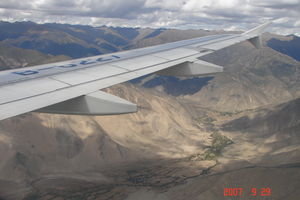Advertisement
Published: November 14th 2007

 Flight to Lhasa
Flight to Lhasa
A rare human establishment in an otherwise huge expanse of uninhabited rugged mountains. This view went on for several hours of our flight. Did you know that China had such sparsely inhabited terrain??? After flying about 5 hours west out of Shanghai, over barren expanses of mountain regions, we touch down in the land of Xizang, Chinese name for Tibet. It's as different from Shanghai as Detroit is from the California coastal region. The thin air at the 12,140' altitude takes our breath away making walking even 1 flight of stairs a lung choking workout. The people are darker with high cheekbones - just like comparing our sun deprived Detroiters to the California beach babes. Yes you can tell the difference between a Tibetan and a Chinese person. We spend a few days in this region to acclimatize before venturing further on our trip to higher alititudes.
Prayer flags are ubiquitous in Tibet. They are in 5 different colors to represent the 5 elements. I didn't want to tell our Tibetan guide that clouds, fire, water, sky, and earth could not be found on the periodic table of elements. To them, their Buddhist beliefs are more real and pertinant than any scientific discovery or characterization. So many geology questions could not be answered. Equally as many political and historical questions could not be answered. Either they simply don't know the answer or "We

 Lhasa arrival
Lhasa arrival
Greeted with the white kadack (spelling correct???) to represent purity, we are a bit apprehensive, but ready to see what this remote region has to hold.are not allowed to talk about this". So in retrospect, while we could read up on the region to find the answers to the many questions this tour inspired, in the absence of those resources, our first-person experience has left us with impressions and understanding which could not be gathered from reading a hundred such resources.
Our 10 day itinerary is personalized with a private english speaking guide, driver, and 4WD vehicle. Yet, we wonder if we will find monastery after monastery an interesting tour, as this and the scenery seem to be the main way to experience this culture. Tibet does not disappoint us. Each monastery and each turn in the road brings unbelievable shocks and surprises. In this first blog from our trip, check out our photos and captions and enjoy a little break from your world. Wherever you are reading this from, if it's not Tibet, it's bound to be surprisingly different!
Advertisement
Tot: 0.071s; Tpl: 0.017s; cc: 10; qc: 25; dbt: 0.0365s; 1; m:domysql w:travelblog (10.17.0.13); sld: 2;
; mem: 1.1mb

 Flight to Lhasa
Flight to Lhasa
 Lhasa arrival
Lhasa arrival






































